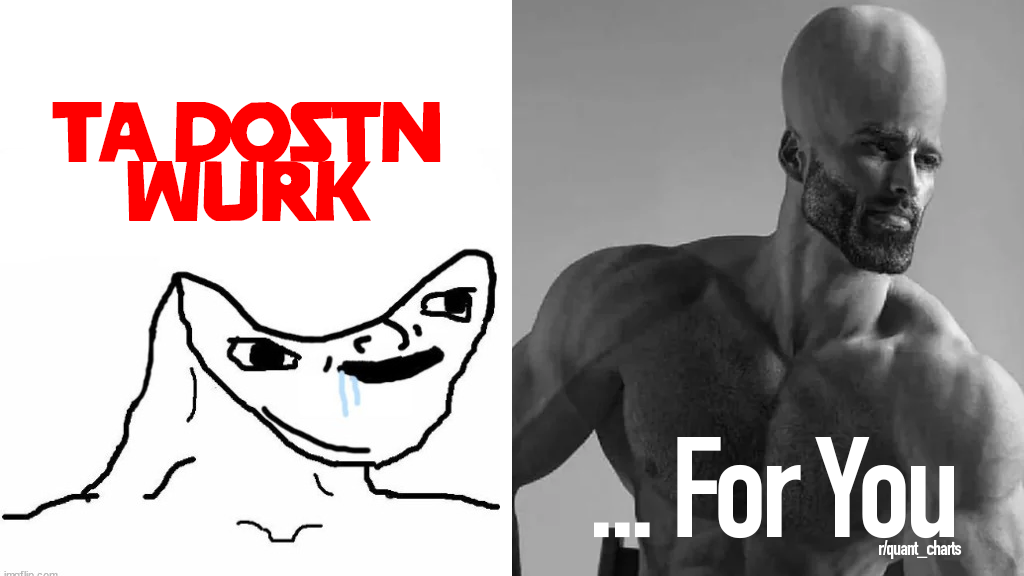How Quants & AI Do TA
 Quant Charts
Quant Charts
We do TA differently than most people. Want to learn a few of our secrets?
We don't try and predict what the chart is going to do. We predict when whales are most likely to buy in.
One task is much easier than the other. But they both have about the same benefit. When funds, billionaires, insiders buy, they don't just throw yarrow sticks. They use criteria to determine timing. All you have to do is figure out what criteria they use.
This is why we use TA. And this is why we do TA differently than most people. We use TA to reverse engineer billionaires' decision-making process.
First thing you have to do is realize you need a filter for survivorship bias or confirmation bias. You have to objectively make sure you're not fooling yourself. Eventually, when your good luck streak ends, you'll go broke. Especially since we tend to bet more the luckier we seem to get.
Next, you've got to define literally everything. You need to micro-nano define everything. For example, I've seen people call a PA geometric a head and shoulders. It wasn't. But the price still went down. Then they proclaim that they called it.
In the algo I'm running, I have 37 different variations of possible head and shoulders. Then I have 9 different variations of confirmed head and shoulders. I have about 11-15 different invalidation conditions for each confirmed head and shoulders, 5-8 confirmation conditions, several take profit conditions, several more close conditions, a few stop profit conditions, and 2-3 immediate market close conditions for each confirmed head and shoulders.
You don't just kinda wing it.
The reason this is crucial is because you have to know the success rate of each setup. Without knowing that, you can't possibly know your risk-reward ratio.
After meticulous definition of a chart pattern like a head and shoulders, we have about a 92.8% success rate to target 1. 71% success rate to target 2. So on.
But let's say a perfectly vetted head and shoulders pattern only had a 51% odds of hitting target 1. Would you still bet that? Las Vegas makes billions of dollars a year on that 1%. Do not make the mistake of discounting the value of a 1% edge.
Then you factor in something like a 1h RSI divergence with a 67% probability, a CVD divergence with 62% odds, and even throw in something as esoteric astronomical event with a low 56% probability and what do you get?
You get a 97.2% chance of winning your trade to target 1.
Here's how to do the math:
Step 1: Convert all percentages to decimals.
Head and Shoulders (H&S) pattern: 51% → 0.51
RSI divergence: 67% → 0.67
CVD divergence: 62% → 0.62
Astronomical event: 56% → 0.56
Step 2: Find the probabilities of each event not happening.
H&S not hitting: 1 − 0.51 = 0.49
RSI divergence not happening: 1 − 0.67 = 0.33
CVD divergence not happening: 1 − 0.62 = 0.38
Astronomical event not happening: 1 − 0.56 = 0.44
Step 3: Multiply the probabilities of the events not happening.
- 0.49 × 0.33 × 0.38 × 0.44 = 0.0272
Step 4: Subtract the result from 1 to get the probability of at least one event happening.
- 1 − 0.0272 = 0.9728
You're basically filtering out risk.
Anyways, I'll start showing you how to properly define head and shoulders, wedges, channels, other patterns, harmonics, waves, indicators, and how to build in early warning invalidation criteria.
Just drop your email and I'll send you a link to our community. I'm looking forward to getting to know you.
Here's a link to our public community while you wait.
Subscribe to my newsletter
Read articles from Quant Charts directly inside your inbox. Subscribe to the newsletter, and don't miss out.
Written by

Quant Charts
Quant Charts
I'm a quant. I do deep mathematical analysis for statistical advantage.